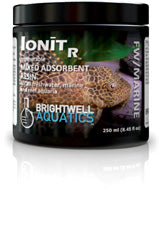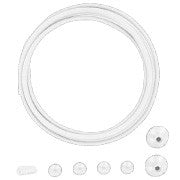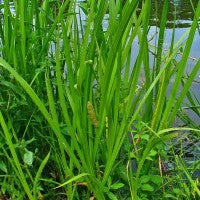Brightwell Aquatics IonitR Brightwell Aquatics
$ 48,50 $ 29,10
Regenerable Mixed Adsorbent Resin for all Freshwater, Marine and Reef Aquaria
Overview
- High-capacity, regenerable adsorption resin effective in marine and freshwater aquaria.
- Dramatically improves water quality by removing dissolved organic material, toxic gasses, heavy metals, and other impurities.
- Helps control nutrient levels (including ammonia, nitrite, nitrate, and phosphate).
- Will not negatively impact water quality once exhausted.
- Regenerable over 250 times, significantly increasing cost effectiveness relative to activated carbon when comparing filtration capability.
Instructions and Guidelines
How to use: Rinse in fresh water prior to use. Employ one 500-ml container per 200 US-gallons of water in aquarium system. Place resin inside a filter bag in an area of moderate water flow, or in a canister or fluidized filter per manufacturer’s instructions. Resin may be left in system continuously if desired. If aquarium water is particularly discolored and/or odorous, amount of resin per gallon of water may be increased up to double (e.g. 500-ml resin per 100 US-gallons). Resin beads will gradually darken to honey brown coloration with exhaustion. Regenerate as directed on opposite panel.
When to regenerate: Regenerate after 5 – 10 days of continuous use, or when water ceases to clear any further and begins to yellow. The more discolored the aquarium water, the more frequently regeneration is required.
How to regenerate: Dissolve 4 cups table salt in 1 US-gallon of room-temperature water per 250-ml resin to be regenerated in a clean pail; place resin into pail and stir; allow beads to soak overnight; strain and rinse beads thoroughly in fresh water before re-using. Resin may not regain original coloration after regeneration, but may be off-white or cream-colored. It may be necessary to repeat regeneration process until resin attains this coloration if it was employed in a system with elevated content of humic and/or tannic acid. Do not regenerate resin with bleach, which will damage resin and could kill aquarium inhabitants.
| Size | 250ml, 500ml |
|---|
Fast Shipping and Professional Packaging
We can offer a variety of shipping options thanks to our long-term relationship with UPS FedEx DHL. Our warehouse staff will package all goods to our exacting requirements. Prior to shipping, your goods will be thoroughly examined and securely secured. We deliver to thousands of customers every day from all over the world. This is a sign of our determination to be the largest online retailer in the world. Warehouses and distribution centers are located throughout Europe as well as in the USA.
Note: Orders that contain more than one item will be assigned a separate processing time for each item.
Prior to shipment, we examine the items ordered thoroughly before sending the items. Most orders are shipped within 48 hours. The expected delivery time is 3 to 7 days.
Returns
The stock is constantly changing and cannot be fully controlled by us due to the involvement of many different parties, such as the factory and our warehouse. The levels of stock can change at any moment. You may not receive your order once the order has been made.
The policy is 30 days. If it's been longer than 30 days since you made your purchase and we're unable to offer you a complete exchange or refund.
To be eligible for a return your item must be unused and in the same condition as you received it. You must have the item in its original packaging.
Related products
RO/DI
Conditioner
Bacteria
Plant Fertilisation
Substrate
Freshwater Plant
Substrate
Plant Fertilisation
CO2 Accessories
Filter Media
Filter Media
CO2 Accessories
Bacteria
Plant Fertilisation
Air Pump Accessories
Plant Fertilisation
Freshwater Plant
CO2 Accessories




































